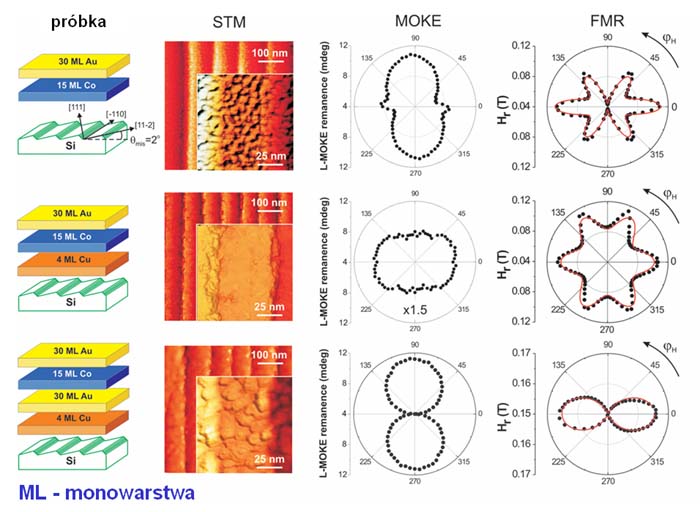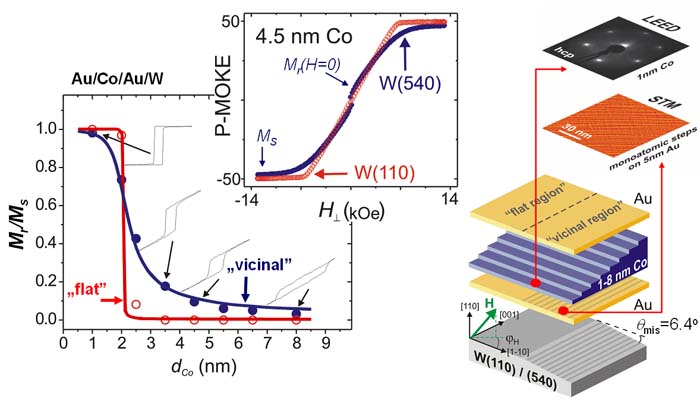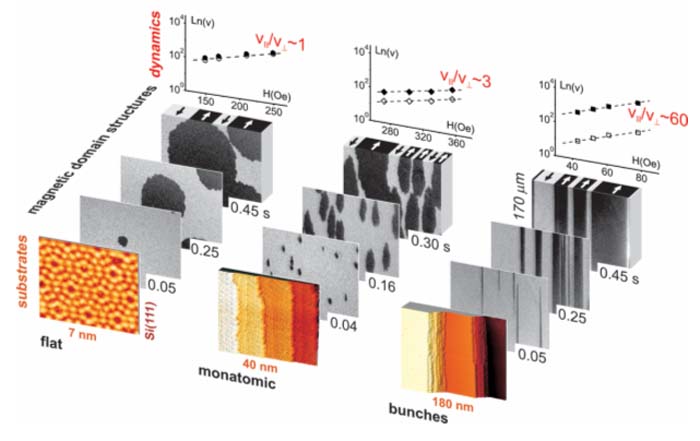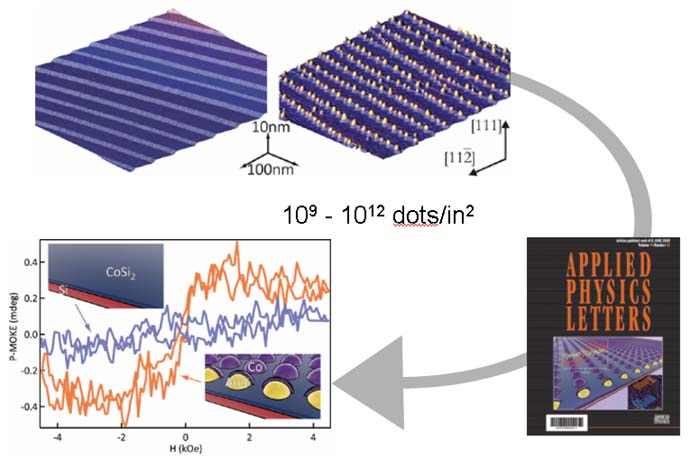Magnetic nanostructures on vicinal substrates
Introduction
The subject of the research is to perform a complex study of the magnetic nanostructures on surfaces with broken translational symmetry. In a low-dimension crystalline structure, the symmetry breaking by the presence of a surface with different geometry and morphology, leads to a number of physical phenomena. This happens because of the surface induced modification of the electron wave functions, resulting in changes in the total energy. As a consequence, in physics of magnetism, the studies of surfaces and ultrathin magnetic films have attracted a lot of fundamental phenomena and have lead to a continuously increasing number of applications in magnetic storage media (GMR, MRAM, itp).
The basic idea of the investigation had been to use a vicinal substrate (Al2O3, Mo, W, Si) with a stepped structure (either single steps or bunches) as a template for the growth of ultrathin Co films with different buffer layers (Mo, Cu, Au). In next step, all the samples have been capped with an Au protective layer enabling an ex-situ study. The samples have been prepared by molecular beam epitaxy (MBE) in an ultra-high vacuum system. The surface and structure properties of the layers have been monitored in-situ by electron diffraction techniques (LEED and RHEED) and by the scanning tunneling microscopy (STM). A strong influence of both substrates and buffer layers on magnetic ordering of ultrathin cobalt films has been found. Magnetic and optics measurements have been performed at room temperature by means of ferromagnetic resonance (FMR) X- band spectrometer, magneto-optical Kerr effect (MOKE) based magnetometer and microscopy, and magnetization-induced second harmonic generation (MSHG) spectroscopy.
Results
The main objectives of this work are the following:
– modification of the magnetocrystalline anisotropy and step-induced magnetic anisotropy in a configuration Co/Si, Co/Au and Co/Cu films have been observed,

– induction of the out-of-plane magnetization state and spin reorientation transition, from perpendicular to in- plane magnetization orientation, have been observed for wide range (1-8 nm) of the cobalt thickness and for different geometry of the W and Mo substrates. A phenomenological model that describes the magnetic anizotropy of the Co films on the vicinal surface well, involving only magnetic parameters of the film on the flat substrate and the geometrical factor of vicinality have been proposed,

– it has been established, that the process of up-down magnetization switching in Co films on vicinal substrates could be induced by both perpendicular and in-plane external magnetic fields,
– modification of the exchange stiffness tensor at monatomic steps turns out to be a driving force for highly anisotropic dynamics of magnetic domain walls. In particular, the velocity of domain walls is increased by 2 orders of magnitude for Au/Co/Au films on bunched Si substrate.

The obtained results can be used to create new artificial systems with desired magnetic properties and reduced dimension down to atomic scale. Particularly interesting are combined nanostructured metallic magnetic systems with semiconducting vicinal substrates that may be the key to create spintronic devices as well as patterned magnetic media.

Reference
- A. Stupakiewicz, Z. Kurant, A. Maziewski, L.T. Baczewski A. Maneikis, A.Wawro, J. Magn. Magn. Mater. 290-291, 242 (2005).
- A. Stupakiewicz, R. Gieniusz, A. Maziewski, K. Postava, A. Wawro, L.T. Baczewski, phys. stat. sol. (b) 243, 202 (2006).
- A. Stupakiewicz, M. Tekielak, A. Maziewski, V. Zablotskii, L.T. Baczewski, A. Wawro, J. Magn. Magn. Mater. 316, e136 (2007).
- A. Stupakiewicz, A. Maziewski, M. Ślęzak, T. Ślęzak, M. Zając, K. Matlak, J. Korecki, J. Appl. Phys. 103, 07B520 (2008).
- A. Stupakiewicz, A. Fleurence, A. Maziewski, T. Maroutian, P. Gogol, B. Bartenlian, R. Mégy, P. Beauvillain, IEEE Trans. Magn. Vol. 44, 11, 2887 (2008).
- A. Stupakiewicz, A. Maziewski, K. Matlak, N. Spiridis, M. Ślęzak, T. Ślęzak, M. Zając, J. Korecki, Phys. Rev. Lett. 101, 217202 (2008).
- A. Stupakiewicz, A. Kirilyuk, A. Fleurence, R. Gieniusz, T. Maroutian, P. Beauvillain, A. Maziewski, Th. Rasing, Phys. Rev. B 80, 094423 (2009).
- A. Stupakiewicz, E. Vedmedenko, A. Fleurence, T. Maroutian, P. Beauvillain, A. Maziewski, R. Wiesendanger, Phys. Rev. Lett. 103, 137202 (2009).
- E. Moyen, M. Macé, G. Agnus, A. Fleurence, T. Maroutian, F. Houzé, A.Stupakiewicz, L. Masson, B. Bartenlian, W. Wulfhekel, P. Beauvillain and M. Hanbücken, Appl. Phys. Lett., 94, 233101 (2009).
